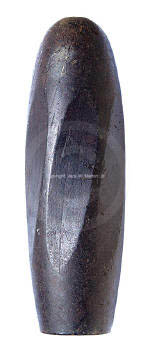Great Britain
Whitworth Pattern I, Sub-pattern II
DIAMETER: 2.73 inches across flats
GUN: 12-pounder Whitworth rifle, 2.75-inch caliber
LENGTH: 9 7/8 inches
WEIGHT: 12 pounds 11 ounces
CONSTRUCTION: Solid shot
SABOT: None
FUZING: None

United States Military Academy Museum, West Point, NY
"...to projectiles made in a spirally shaped form, so as to fit exactly the interior of a piece of ordnance or fire-arm made of a corresponding form."
He later patented an improvement in projectiles dated December 30, 1859, Great Britain patent #2990, which stated:
"...in so forming the projectile that the rear part may have a proper relation to the fore part with regard to their respective shapes and weights. The shape of the fore part depends upon the purpose for which the projectile is to be employed, and may be more or less pointed or curved, or flat fronted. The rear part is made to taper, and the weight, form, and degree of convergence given to it must be determined by and adapted to those of the fore part. The parts thus mutually adapted present their surfaces to the action of the air under conditions most favourable to the accuracy, velocity, and range of the projectile."
The tapered rear is what determines this as a Pattern I, Sub-pattern II Whitworth projectile. Click here to see the 12-pounder Whitworth case-shot.
Great Britain
Whitworth Pattern I, Sub-pattern II
DIAMETER: 2.71 inches across flats
DIAMETER OF RIDGES: 2.966 inches
DIAMETER AT BASE: 2.10 inches
GUN: 12-pounder Whitworth rifle, 2.75-inch caliber
LENGTH: 9.39 inches
WEIGHT: 12 pounds
CONSTRUCTION: Solid shot
SABOT: None
FUZING: None
All measurements of this Whitworth were made with a Starrett,
No. 721, Digital Calipers; accuracy +/- .001".
Authentic Whitworth projectiles will have most of the following features:
- Lathe dimple in the nose. This is not always visible or present but usually.
- Machining grooves on the sides of the outer ridges. Grooves are not always visible due to exposure to elements. Some of the weathered Bannerman surplus are salt & pepper pitted so these grooves might not be visible.
- Flats. The flats are concave and not completely flat. They also should be less that 2.74 inches in diameter.
- The outside diameter of the ridges should never be more than 2.98 inches.
- If you see a Whitworth with a hole drilled into the nose, that is almost the entire length, and the hole is the same diameter all the way to the end, then it isn't a real Whitworth projectile. Post-war Gettysburg monument Whitworth's projectiles are slightly larger in diameter and have holes in the solid cast replica's so that they can be mounted in a pyramid. The replicas were held together with a threaded rod screwed into the nose of two facing replicas. A few monument or replicas maybe around with no holes but have a vertical casting seam. These replicas are always larger in diameter than the Civil War period Whitworth projectiles. Also note: Civil War period Hotchkiss, Absterdam, and real Whitworth shells were also used on these Gettysburg monuments.
- Most Whitworth projectiles were manufactured in Great Britain. The Confederacy did manufacture a few Whitworth projectiles but these are very rare.
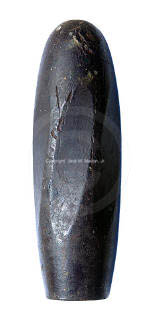
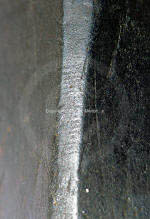
Machining grooves
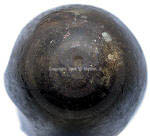
Lathe dimple in nose
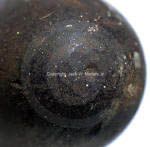
Lathe dimple in nose
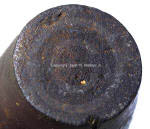
Base is flat. You can see the casting vent, in the center, where it was removed.
